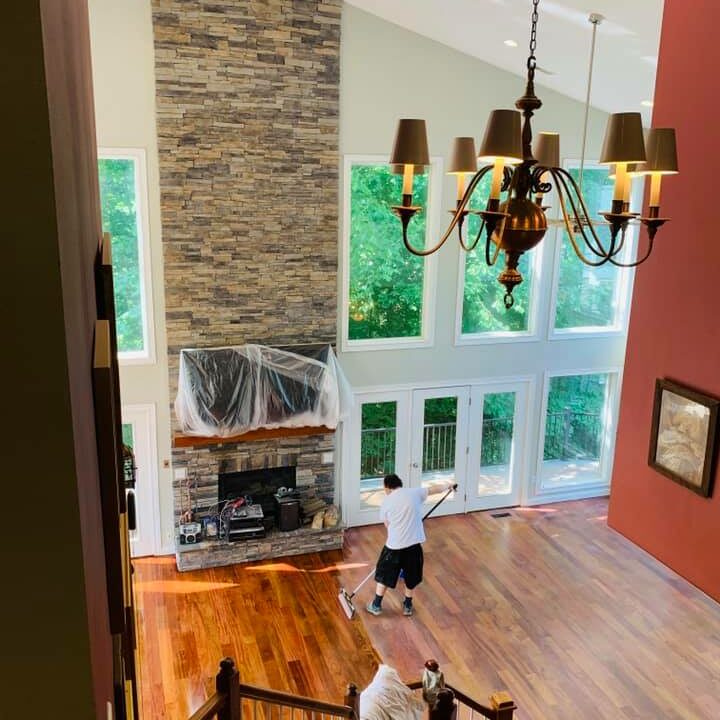Hardwood Floor Varnishing
Hardwood Floor Varnishing
A varnish finish on your hardwood floor is one of the most proactive steps you can take in protecting your flooring investment. Varnish creates a layer of protection over your wood floor, safeguarding it from most impacts, spills and other damage. Varnish also helps to fill and seal the wood’s pores, preventing dust collection and keeping maintenance minimal. Discover facts about BEAUTIFUL HARDWOOD|
A professional varnish finish should last for ten years or more, making this a cost-effective long term investment. If your varnish is beginning to wear, Gramer Flooring also provides revarnishing and hardwood maintenance services.

Types of Varnishing
Natural Varnish
The traditional varnish is based on natural resins and oils and is thinned with mineral spirits or turpentine. Spar varnish is a natural varnish formulated to stay tacky; it should never be used for furniture. Synthetic varnishes are based on synthetic resins and require special thinners.
Artificial Varnish
The best of the artificial varnishes is that the polyurethane type; polyurethanes area unit clear, non-yellowing, and very tough. Other artificial varnishes area unit the phenolic, used for exterior and a few marine works, and the alkyds, often used in colored preparations. Phenolic and alkyd varnishes yellow with age and is not recommended for refinishing. With any variety of varnish, look for quick drying to minimize dust problems.
Water-Base Varnishes
Water-base varnishes provide similar results while not the cleanup problem and toxicity. Most dry clear to the bit in fifteen to half-hour. They don’t crack, chip, or bubble, and that they area unit water- and alcohol-resistant. Best of all, these varnishes do not yellow. However, once applied in many coats, the end would possibly begin to cloud, depending on the wood.

Special Requirements
Natural varnish is used with any stain or filler. The sealer for natural varnish is thinned shellac or a mixture of 1 part varnish and 1 part turpentine or mineral spirits. Do not mix brands or types of varnish. Polyurethane varnish is not compatible with all stains and fillers. Before shopping for, scan the labels to form positive you are victimization compatible materials.
Water-base varnish can be used over stain and filler, provided you allow the undercoats to fully cure. This process can take up to a month. You can also apply a sealer coat of shellac between the two if you don’t want to wait.
Be aware that varnish generally dries very slowly and can be difficult to apply, so it’s important to know how to use this finish.
Application Techniques
- Apply varnish with a new, clean, natural-bristle brush. Use only new varnish. Varnish that is been used many times could contain lumps of hardened varnish from round the sides and rim of the instrumentality. These lumps can really cause trouble. If you plan the job properly, you probably won’t have enough varnish left to be wasteful. Leftover varnish is used on components that will not show or comes wherever the end is not important.
- Bare wood to be finished with varnish must be properly prepared, and sanded. Finished wood to be top-coated must be cleaned and lightly sanded. Right before applying the varnish, you must clean each surface thoroughly with a tack cloth so as to ensure that there is no dust particles clung to it.
- It’s much easier to apply varnish to horizontal surfaces than vertical surfaces. Before you begin to figure, turn the piece of furniture so that its major surfaces are horizontal. If the piece has drawers,, shelves, doors and other removable parts; you should take them out and then finish off the varnish. Work on only one surface at a time, and work on large surfaces last.
- Apply varnish to the ready wood with long, smooth, even strokes, laying the varnish along the grain in strips the width of the brush. Do not bit the comb to the rim of the varnish instrumentality; shake or faucet off excess varnish within the container or on a strike will. The varnish ought to flow onto the surface of the wood, with no drag.
- For natural varnish, use turpentine or mineral spirits. For polyurethane varnish, use the thinner recommended by the manufacturer. Stir the agent gently into the varnish, being careful to not raise any bubbles.
Why Gramer Flooring for Varnishing
We are trained professionals and will insure the highest quality work. Our team are experts at doing the job rightly and efficiently.